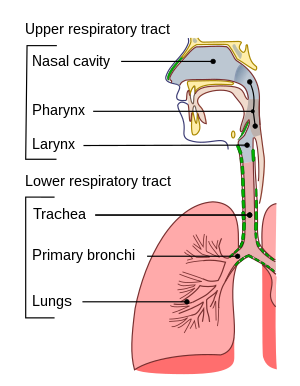Respiratory tract infection
| Respiratory tract infection | |
|---|---|
 |
|
| Conducting passages | |
| Classification and external resources |
Respiratory tract infection refers to any of a number of infectious diseases involving the respiratory tract. An infection of this type is normally further classified as an upper respiratory tract infection (URI or URTI) or a lower respiratory tract infection (LRI or LRTI). Lower respiratory infections, such as pneumonia, tend to be far more serious conditions than upper respiratory infections, such as the common cold.
Although some disagreement exists on the exact boundary between the upper and lower respiratory tracts, the upper respiratory tract is generally considered to be the airway above the glottis or vocal cords. This includes the nose, sinuses, pharynx, and larynx.
Typical infections of the upper respiratory tract include tonsillitis, pharyngitis, laryngitis, sinusitis, otitis media, certain types of influenza, and the common cold. Symptoms of URIs can include cough, sore throat, runny nose, nasal congestion, headache, low grade fever, facial pressure and sneezing.
The lower respiratory tract consists of the trachea (wind pipe), bronchial tubes, the bronchioles, and the lungs.
...
Wikipedia
